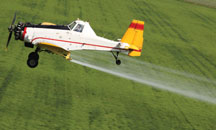
Spray Drift Reduction Adjuvants
Regulatory agencies may soon require buffer zones around sprayed farm fields. A proposed ASTM International standard will be used to measure the drift reduction performance of tank mix adjuvants designed to reduce spray drift during the application of pesticides. Farmers can decrease the size of these buffer zones by using these adjuvants.
ASTM WK27419, Test Method for Characterization of Performance of Spray Drift Reduction Adjuvants, is being developed by Subcommittee E35.22 on Pesticide Formulations and Delivery Systems, part of ASTM International Committee E35 on Pesticides and Alternative Control Agents. "Regulatory agencies such as the U.S. Environmental Protection Agency are moving toward requiring buffer zones around fields," says Curtis Elsik, senior technology manager, Huntsman Corp., and chairman, E35.22. "The size of the buffer zone is a function of the potential of the spray to move off-target."Buffer zones can be minimized by decreasing the amount of fine particles in the pesticide spray. The volume of these small particles can be reduced with proper spray nozzle selection and other application parameters. In addition, tank mix additives that function under one of several available drift reduction technologies can be used to reduce the amount of fine particles formed during atomization of the pesticide spray mixture.
Elsik says that ASTM WK27419 would provide a guideline on how to measure the change in volume of fines produced using any drift reduction technology tank mix additive. Additive manufacturers, along with raw material suppliers, pesticide producers and distributors, and government agencies, will be the primary users of WK27419 once it has been approved. Farmers would be able to use results from the test method to determine the buffer zone size needed around their fields.Elsik notes that, once ASTM WK27419 is approved, its success will depend on the use of standards developed by ASTM Committee E29 on Particle and Spray Characterization. These standards are needed to measure aerosol particle size distribution using laser diffraction or other means.
CONTACT Technical Information: Curtis Elsik, Huntsman Corp. • The Woodlands, Texas • Phone: 281-719-7491 • E-mail: curtis_elsik@huntsman.com O ASTM Staff: Jennifer Rodgers • Phone: 610-832-9694 • E-mail: jrodgers@astm.org O Upcoming Meeting: Oct. 11-14 • October Committee Week • San Antonio, Texas
 SN Home
SN Home Archive
Archive Advertisers
Advertisers Masthead
Masthead RateCard
RateCard Subscribe
Subscribe Email Editor
Email Editor